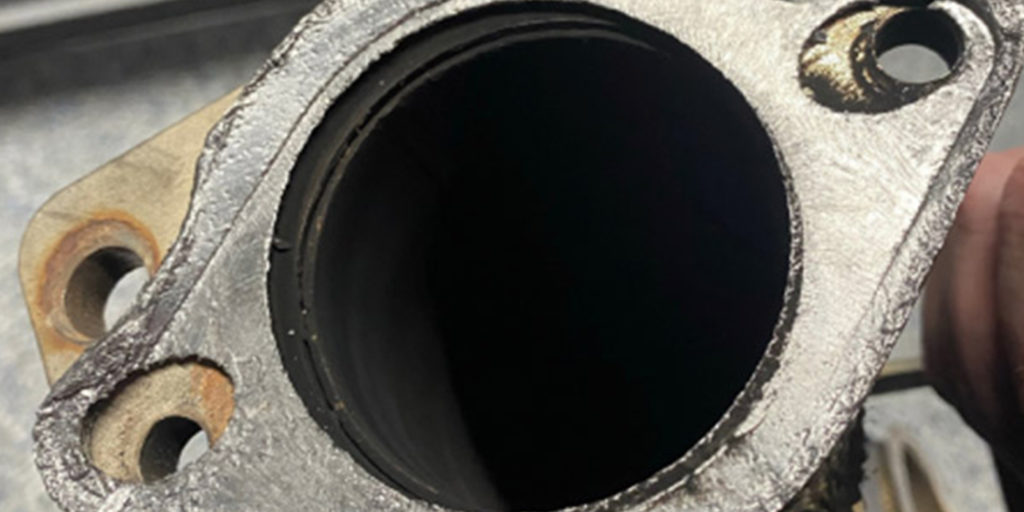In the early 1990s, exhaust systems started to shift from mild or aluminized steel to 409 stainless steel. The change in materials was needed due to higher exhaust temperatures and the demand to reduce vehicle weight. This change in materials put a lot of traditional muffler shops out of business. Today, these “lifetime” exhaust systems require different types of repair.

Way back when, a lot of undercar shops had a Huth pipe bender. Using different program cards, the shop could bend a header-back exhaust system out of straight lengths of pipe stock. It was expected that those systems would last 25,000 to 35,000 miles. Stainless steel changed this.
The first problem was that stainless steel simply does not bend like mild steel – in addition, hangers and flange joints became more sophisticated to reduce noise and vibration.
The answer to the production problem for the majority of shops was pre-bent or direct fit exhaust components. Over the past 25 years, many exhaust suppliers saw their catalog of direct-fit parts expand to cover more applications.
Direct Fit
Direct fit parts can be used to make an effective repair quickly. If you are dealing with a section of the exhaust system around catalytic converters and oxygen sensors, a direct-fit part can prevent a comeback. Even small exhaust leaks can inhibit the exhaust stream gases from being measured by the upstream and downstream oxygen sensors. This can result in codes indicating lean fuel trims and catalyst efficiency.

Direct-fit components can be made from aluminized steel or stainless steel. Aluminized steel is steel that has been hot-dip coated on both sides with aluminum-silicon alloy. This process creates a strong bond between the steel sheet and coating, but the aluminized layer can be removed by road debris and salt. Also, the coating inside the pipes can be removed by hot exhaust gases. Still, aluminized parts can last a long time on a vehicle at a price the customer can afford.
OEMs and aftermarket exhaust suppliers use 409 stainless steel. As with aluminized steel, a magnet will stick to the surface of 409 stainless. This type of steel includes 10-12 percent chromium and nickel to improve corrosion resistance, but it will still corrode over time. Also, the corrosion can occur from the inside out. Areas around the welds erode first due to the changes to the metallurgy caused by heat.

High-performance exhaust systems are typically made of 304 stainless steel. This type of stainless steel has 27-30% chromium and nickel. A magnet will not stick to the surface. High temperatures will cause the surface to have a blue color. These systems can cost three times more than an aluminized steel system.
Flex Pipes
One thing that changed with the materials was how exhaust systems compensated for the movement of the engine and body. In the past, ball flanges were used at the headers to allow for motor movement. With the switch to transversely mounted engines, a more flexible joint was needed. Enter flex pipes with metal bellows and braided stainless-steel mesh on the outside.

For most exhaust systems, the flex pipe is not a serviceable item that can be unbolted. The section with the flex pipe might extend from the catalytic converter to the rear mufflers. The section might include a resonator and application-specific hangers. If the application is not popular, finding an economical replacement can be difficult.
While most technicians have the tools to cut exhaust pipe to remove the pipe, inserting and securing the new flex joint is where different methods often need to be applied.
Welding
Welding is always an option, if your shop is up to it. Welding 409 stainless steel requires skills, a welder and the correct wire. The skill part comes in adjusting the voltage and heat at the site of the weld. If the weld is too cold, the weld will not penetrate. If the weld is too hot, the weld and pipe can crack. Using mild steel welding wire can result in corrosion. However, with training and the right welder, you can give long-lasting results when grafting a new flex pipe or hanger on a system.
Clamps
The other option is to use clamps. Exhaust suppliers do have special clamps that can create a mechanical connection and a complete seal. Some clamps are made of stainless steel to match the pipe.
Different style clamps have different installation methods. Stainless steel pipes are harder than aluminized steel. For some applications, U-bolt or saddle-style clamps might create a robust mechanical connection but can leak. Band-style clamps can come in many styles and lengths. These types of clamps can seal the connection and make the joint easy to service if the exhaust system needs to be removed to drop a fuel tank or chassis component.
The important thing to remember is to decide what type of clamp you plan to use before you start cutting. Some clamps require more overlap of the pipes to seal and connect the pipes.
What is the future? Exhaust systems will continue to be made of stainless steel. More systems will have double wall construction to keep the heat inside the exhaust system to improve efficiency. Also, more manufacturers will use the heat of the exhaust to heat transmission fluid and engine oil to reduce cold start emissions.
The good news is, exhaust service is still alive.














